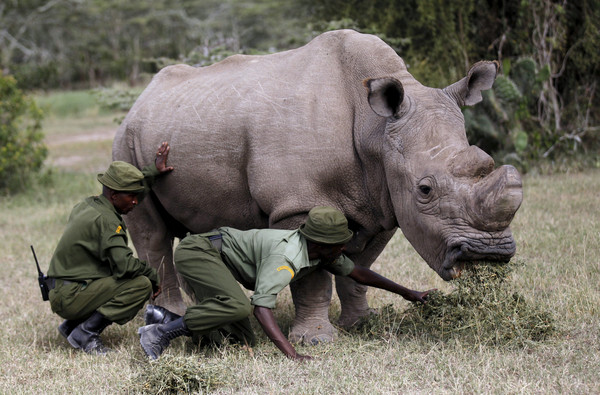Climate and environmental changes necessitate more species to be protected by humans. In this month’s Spotlight, we take a closer look at the success stories of animal conservation, specifically the revival of the pandas and the white Rhinos.
White rhinoceros are one of the most interesting cases of somewhat successful wildlife conservation. White rhinos, once fewer than 100 individuals in the early 1900s, are now the most abundant rhino subspecies, reaching a population of 20,000 and outnumbering all other rhino subspecies combined.
White rhinos originate from two parts of Africa: northern white rhinos are usually found in the grasslands and savannahs of East and Central Africa, whereas their southern counterparts are usually found in the southern parts of Africa including Namibia, Botswana, Zimbabwe, and Eswatini. White rhinos are the biggest living species of rhinoceros and do not have many predators due to their size and armor-like skin. If you have seen a rhino, then it was likely a white rhino as they are the most abundant species of rhinos and are highly social, thus making them popular in zoos. Unlike what their name suggests, there is nothing about white rhinos that resembles ‘white’. A popular theory is that the word “white” came from a mistranslation of the Dutch word “wijd”, which means “wide” in English. However, linguists have failed to produce any evidence that the word “wijd” was ever used to describe the rhino.
White rhino conservation was one of the most dramatic examples showcasing how international politics can affect the wildlife ecosystem. Historically, white rhinos were first introduced to the western world when famous naturalist William John Burchell first saw and documented what he called the “square-lipped rhinoceros” on October 16, 1812. The publication of his description and drawings in 1817 sparked the interest of European hunters which, combined with advances in firearm efficiency, meant that the white rhino would quickly begin to disappear from many areas in its once extensive range. Their social nature didn’t help them either; being herd animals and having lower aggression made them the preferred target over black rhinos. This unregulated hunting eventually drove them to near extinction, with a population of less than 100.
This quickly took a turn in 1895 when colonial conservationists were able to convince authorities to establish Africa’s first protected conservation area, the Umfolozi Junction Reserve, with the intent of saving the white rhino. This allowed the rhino population to grow up to 400 by 1950. In 1960, Ian Player, an outstanding conservationist and environmental statesman, began “Operation Rhino”, which aimed to relocate white rhinos, restore them to their ranges, and accelerate their growth, leading to the current white rhino population of 15000. However, the successful conservation story that we’ve been reading only applies to southern white rhinos. As of 2024, only two northern white rhinos are left on Earth, making them one of the most endangered species in the world. But why is there such a difference between the number of northern and southern white rhinos?

One reason is the difference in political stability across Africa. Northern white rhinos live in Sudan, South Sudan, and Congo — countries that are still at war or suffering from chaotic political situations. Although specific numbers aren’t documented, it is estimated that the population of northern white rhinos fell from 2000 to 500 between 1960 and 1975. Even though there were some efforts to protect white rhinos during this period, conflicts that occurred in the habitats of northern white rhinos, such as the First Sudanese Civil War and the Congo Crisis, limited the resources these countries could dedicate toward wildlife conservation, whereas southern white rhinos were able to grow under relatively stable conditions. It’s a clear example that shows how international politics plays a part in wildlife protection as well as the extent to which it can create discrepancies between species.
Despite the issues faced in the protection of northern white rhinos, both species of white rhinos still remain positive examples of wildlife conservation. Southern white rhinos are, without a doubt, a great example of successful wildlife preservation despite concerns about their genetic diversity. Research on restoration through in vitro fertilization using southern white rhinos as surrogate mothers has been ongoing for a few years and has made important breakthroughs. Earlier this year, the Leibniz Institute for Zoo and Wildlife Research in Germany, which also is a member of the white rhino conservation consortium BioRescue, confirmed that they were able to successfully implant an embryo cell into the surrogate mother. Although the surrogate mother tragically died due to Clostridium infection, a post-mortem examination revealed that the implant was successful and the male fetus was growing well with a 95% chance of being born alive. Despite some critics arguing that pouring more money and resources into a species that's as good as lost could be better used in saving more viable species, there is no doubt that successful restoration of an endangered species will change how we look at and approach the current ecological crisis.

